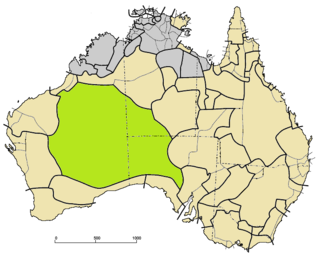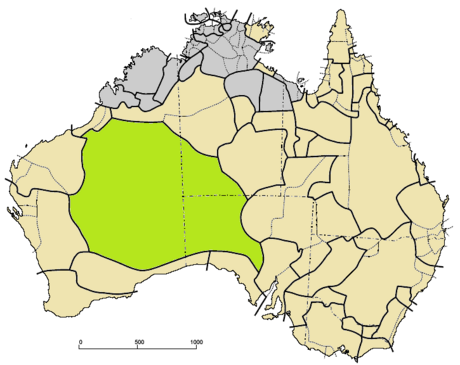The Western Desert language, or Wati, is a dialect cluster of Australian Aboriginal languages in the Pama–Nyungan family.
The name Wati tends to be used when considering the various varieties to be distinct languages, Western Desert when considering them dialects of a single language, or Wati as Warnman plus the Western Desert cluster.
Location and list of communities
The speakers of the various dialects of the Western Desert Language traditionally lived across much of the desert areas of Western Australia, South Australia and the Northern Territory. Most Western Desert people live in communities on or close to their traditional lands, although some now live in one of the towns fringing the desert area such as Kalgoorlie, Laverton, Alice Springs, Port Augusta, Meekatharra, Halls Creek and Fitzroy Crossing.
The following is a partial list of Western Desert communities:
- Kintore, Northern Territory
- Docker River, Northern Territory
- Ernabella, South Australia
- Amata, South Australia
- Fregon, South Australia
- Pipalyatjara, South Australia
- Kalka, South Australia
- Warburton, Western Australia
- Kiwirrkurra, Western Australia
- Balgo, Western Australia
- Aputula, Northern Territory (also known as Finke)
- Imanpa, Northern Territory (also known as Mount Ebenezer)
- Mutitjulu, Northern Territory
- Jigalong, Western Australia
Dialect continuum
The Western Desert Language consists of a network of closely related dialects; the names of some of these have become quite well known (such as Pitjantjatjara) and they are often referred to as "languages".[3] As the whole group of dialects that constitutes the language does not have its own name it is usually referred to as the Western Desert Language. WDL speakers referring to the overall language use various terms including wangka ("language") or wangka yuti ("clear speech"). For native speakers, the language is mutually intelligible across its entire range.
Dialects
Following are some of the named varieties of the Western Desert Language.
| The Language/Dialect | The People | Notes | AIATSIS Reference |
|---|---|---|---|
| Antakarinya dialect | Antakarinya people | C5: Antikirinya[4] | |
| Kartujarra dialect | Kartujarra people | A51: Kartujarra[5] | |
| Kokatha dialect | Kokatha people | C3: Kokatha[6] | |
| Two dialects of the Western Desert language have been named 'Kukatja'; Kukatja (A68) and Kukatja (C7) | Kukatja (A68) and Kukatja (C7) | A68 is in the north of Western Australia near Lake Gregory, and C7 is west of Haasts Bluff in central Australia.[7][8] A68 is one of the dialects that make up Martu Wangka at Jigalong.[9]: iii C7 call themselves 'Luritja' now.[7] | A68: Kukatja & C7: Kukatja[7][8] |
| Kuwarra dialect | Kuwarra people | There is little information regarding the language but the people are well attested.[10][11] | A16: Kuwarra[12] |
| Luritja dialect | Luritja people | The Kukatja (C7) call themselves 'Luritja' now.[7] Pintupi and Luritja are two similar but overlapping dialects.[13][14] | A7.1: Luritja[13] |
| Manyjilyjarra dialect | Manyjilyjarra people | One of the dialects that make up Martu Wangka at Jigalong.[9]: iii | A51.1: Manyjilyjarra[15] |
| Mantjintjarra dialect | Mantjintjarra people | A33: Mantjintjarra[16] | |
| Martu Wangka dialect | Martu people | Martu Wangka refers to either a dialect found at and around Jigalong, Western Australia[9]: iii [17] or many different dialect groups in the Gibson, Little Sandy and Great Sandy deserts.[17] | A86: Martu Wangka[17] |
| Nakako dialect | Nakako people | Little is known of the people and their language[18] | A32: Nakako[19] |
| Ngaanyatjarra dialect | Ngaanyatjarra people | A38:Ngaanyatjarra[20] | |
| Ngaatjatjarra dialect | Ngaatjatjarra people | A43: Ngaatjatjarra[21] | |
| Ngalia dialect | Ngalia people | C2: Ngalia[22] | |
| Pindiini/Wangkatha/Wangkatja dialect | Pindiini/Wangkatha/Wangkatja people | These three dialects & people have been hardly distinguished.[23][24][25] | A102: Pindiini, A12: Wangkatha & A103: Wangkatja[23][24][25] |
| Pintupi dialect | Pintupi people | Pintupi and Luritja are two similar but overlapping dialects.[13][14] | C10: Pintupi[14] |
| Pitjantjatjara dialect | Pitjantjatjara people | C6: Pitjantjatjara[26] | |
| Putijarra dialect | Putijarra people | One of the dialects which make up Martu Wangka at Jigalong[9]: iii | A54: Putijarra[27] |
| Tjupan dialect | Tjupan people | A31: Tjupan[28] | |
| Wangkajunga dialect | Wangkajunga people | A87: Wangkajunga[29] | |
| Yankunytjatjara dialect | Yankunytjatjara people | C4: Yankunytjatjara[30] | |
| Yulparija dialect | Yulparija people | A67: Yulparija[31] |
Language
Status
The Western Desert Language has thousands of speakers, making it one of the strongest indigenous Australian languages. The language is still being transmitted to children and has substantial amounts of literature, particularly in the Pitjantjatjara and Yankunytjatjara dialects in South Australia where there was formerly a long-running bilingual program.[citation needed]
Phonology
In the following tables of the WDL sound system, symbols in ⟨angle brackets⟩ give a typical practical orthography used by many WDL communities. Further details of orthographies in use in different areas are given below. Phonetic values in IPA are shown in [square brackets].[citation needed]
Vowels
The Western Desert Language has the common (for Australia) three-vowel system with a length distinction creating a total of six possible vowels.[citation needed]
Consonants
As shown in the chart, the WDL distinguishes five positions of articulation, and has oral and nasal occlusives at each position. The stops have no phonemic voice distinction but display voiced and unvoiced allophones; stops are usually unvoiced at the beginning of a word, and voiced elsewhere. In both positions, they are usually unaspirated. There are no fricative consonants.[citation needed]
Orthography
While the dialects of the WDL have very similar phonologies there are several different orthographies in use, resulting from the preferences of the different early researchers as well as the fact that the WDL region extends into three states (Western Australia, South Australia and the Northern Territory), with each having its own history of language research and educational policy.[citation needed]
Sign language
Most of the peoples of central Australia have (or at one point had) signed forms of their languages. Among the Western Desert peoples, sign language has been reported specifically for Kardutjara and Yurira Watjalku,[32] Ngaatjatjarra (Ngada),[33] and Manjiljarra. Signed Kardutjara and Yurira Watjalku are known to have been well-developed, though it is not clear from records that signed Ngada and Manjiljarra were.[34]
References
External links
Wikiwand in your browser!
Seamless Wikipedia browsing. On steroids.
Every time you click a link to Wikipedia, Wiktionary or Wikiquote in your browser's search results, it will show the modern Wikiwand interface.
Wikiwand extension is a five stars, simple, with minimum permission required to keep your browsing private, safe and transparent.

